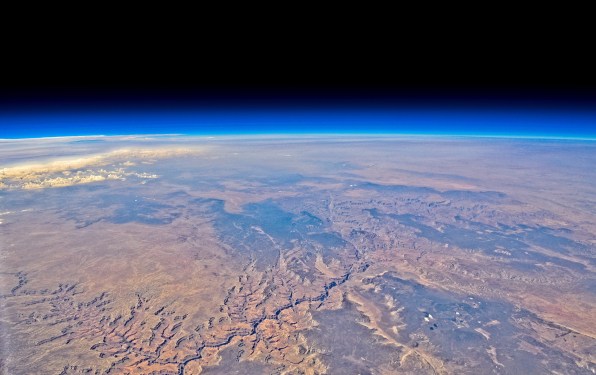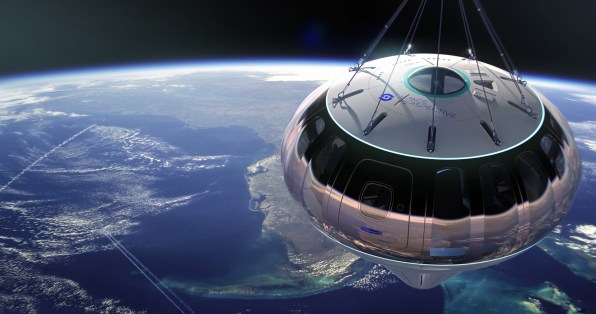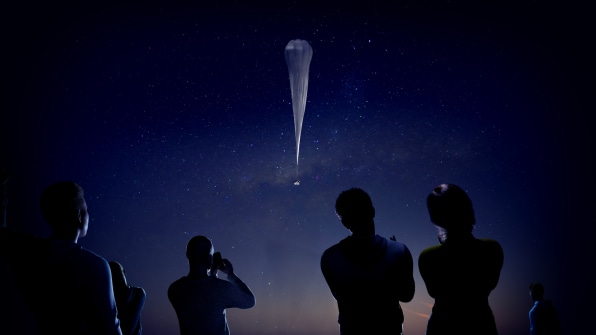- | 12:38 pm
Too poor for space? Ballooning to the stratosphere is the next best thing
Space Perspective and World View promise the same heavenly views for a fraction of the cost of Blue Origin, Virgin Galactic, and SpaceX. Weightlessness not included—but there are cocktails.

Since the Apollo days, astronauts have experienced an existential overwhelm through their reframed view of Earth as a fragile planet against the harshness of space and the vessel of all humanity.
It’s an event so profound that it’s come to be known as the overview effect, a term coined in 1987 by author and space philosopher Frank White. For civilians, it’s reserved for a rarified few who can shell out $450,000 to $55 million for several weightless minutes at the edge of space to several days in orbit aboard the International Space Station.
But in 2024, two companies—Space Perspective, a startup in Florida’s Space Coast, and World View, an established high-altitude balloon firm in Tucson, Arizona—hope to spread that transcendence to more people through comparable views at much lower prices via high-tech ballooning to the stratosphere, a section of the atmosphere still well below space but beyond commercial flights.
For $50,000 to $125,000, tourists aloft both companies’ balloons will be able to slowly drift to a minimum of 19 miles (or 100,000 feet) for vistas that still encompass the curvature of the Earth, blackness of space, and stars that twinkle ever more sharply through the thinner atmosphere. Though participants won’t earn astronaut wings or experience weightlessness—flying well below the internationally recognized Kármán line space boundary at 62 miles (or even NASA’s designation of 50 miles)—the companies hope the experience, coupled with curated companion itineraries, will spark greater environmental and humanitarian concern.

The Grand Canyon from 100,000 feet [Photo: courtesy of World View]
“When astronauts go to space, they’re not just seeing a pretty view; they’re deeply connecting with our planet and the singular human family that inhabits it,” says Space Perspective CEO Jane Poynter, who runs the company with her husband, CTO Taber MacCallum. “And when they come back, they get more involved in social and environmental causes than before they left. You want to take action based on that incredible perspective.”
With the global space tourism market projected to grow by hundreds of millions, if not billions, of dollars during the next decade, Space Perspective and World View are tapping an expanding thirst for space-like experiences—akin to ZeroG’s $8,200 parabolic flights that simulate weightlessness—that offer aspects of the real deal. And since balloon travel doesn’t pose the same risks or demand the training, g-forces, or physical endurance as a rocket launch, it accommodates more elderly, disabled, and medically challenged patrons. Plus, they serve cocktails on the way.
SIMILAR VISIONS
Both Space Perspective and World View use roughly 700-foot-long, gas-filled balloons tethered to pressurized, climate-controlled capsules, 16 to 19 feet in diameter, with 6-foot windows offering 450-mile, 360-degree views. Cabin interiors feature movable, ergonomic seats for eight guests, a pilot, and flight guide, bar and catering consoles, telescopes, Wi-Fi and video conferencing screens to communicate with folks on the ground, information displays, and, of course, bathrooms.

Capsule rendering above Florida [Photo: courtesy of Space Perspective]
While gently ascending, the elongated balloons gradually swell to a 350-foot sphere as the gas expands and the external air pressure decreases. The equalized pressure prevents the balloon from bursting. Initial flights will last around six hours, with a two-hour ascent that begins before dawn to reach apogee in time for the sunrise and a two-hour float, before a two-hour descent. But future locations might involve longer and higher flights.
On the ground, the companies plan to model their environmental messaging by aligning with ecology initiatives and recycling their single-use balloons. Space Perspective is offsetting its carbon footprint by purchasing carbon credits through Cool Effect, a carbon reduction nonprofit. World View is partnering with foresters One Tree Planted and designating some balloon recycling for greenhouses growing new trees. (It also hired actor and environmental activist Adrian Grenier as a sustainability strategist.)

[Photo: courtesy of World View]
“We have to do our own part,” says World View CEO Ryan Hartman. “Our goal is to become climate positive. If we are to contribute to a radically improved future, we need to be consuming more CO2 than we’re producing.”
While these steps are all a great start, these companies will need to also consider their impact on the surrounding communities at their spaceport locations. Successful long-term sustainability also requires involving local businesses and civic leaders in their environmental efforts, says Jonathon Day, a Purdue University associate professor who specializes in sustainable tourism.
“I give them good marks for finding ways to ameliorate the impacts of what they’re doing from the beginning,” he says. “Anywhere that has a transportation hub becomes a place where people visit. Some of these small towns that are launching pads for space tourism are going to need to be thinking about how they’re going to grow. With our presence in space, whether tourism or commerce, we need to make sure we don’t make the same mistakes as the past.”
DIFFERING TECHNOLOGIES
When it comes to ascent and descent, the two companies’ technical approaches diverge sharply.
Space Perspective’s Neptune will use hydrogen to lift off from its Kennedy Space Center spaceport and gently splash down in either the Atlantic Ocean or Gulf of Mexico, depending on the time of year. Balloons will remain attached, slowly releasing the gas to lower the conically shaped craft into the water. A ship will then retrieve the passengers.
World View’s Explorer will use helium to launch from its spaceport near the Grand Canyon. After its craft lowers into the thicker atmosphere, it will trade its balloon for steerable parachute-like parafoils to glide back to its launchpad while a team recovers the balloon. Both will have backup parachutes for emergencies.
HYDROGEN VS. HELIUM
Space Perspective prefers the less expensive and more plentiful hydrogen—the same reasons that have prompted the National Weather Service to convert most of its balloon sites to hydrogen.

Jane Poynter, Space Perspective founder and co-CEO [Photo: courtesy of Space Perspective]
“Technically, one can use either; they’re both good lift gases,” Poynter says. “The challenge with helium is that it is a nonrenewable resource and in very tight demand. Once we’re doing more than a few flights a year, we would be competing with hospitals, which use it for MRIs.”
That, too, is a concern for World View, though it’s sticking with helium for safety reasons (it’s a nonreactive gas that doesn’t burn or explode). “Our use represents less than 1% of the global supply of 10 years, but we’re continuing to study ways to reduce the amount of helium [we use],” Hartman says. “We are certainly aware of all the work going to make the handling of hydrogen safe. But at the end of the day, it’s still hydrogen and it’s very flammable.”
Despite modern-day safety precautions, that characteristic still evokes memories of the 1937 explosion of the Hindenburg, a hydrogen-filled airship that killed three dozen people when it plummeted to the ground in flames.
“We might as well address the elephant in the room,” Poynter says. “But the fact is, the Hindenburg was not a balloon. It was an airship that was not designed for hydrogen and it was also built 85 years ago.”
She elaborates that the hydrogen was not properly contained, therefore it created a flammable mixture with air. It exploded after a spark ignited the craft’s outer skin, which had been covered with an accelerant.
“Balloons have a single container for the hydrogen, so if any were to leak it simply floats up and away. During the thousands of balloon flights conducted with hydrogen since the 1700s, there is not a single recorded incident of a flight accident due to hydrogen.”
OCEAN VS. LAND
Poynter and MacCallum believe fewer technical transitions make for a smoother and safer ride than disconnecting a balloon and opening a parafoil. “It imparts more complexity, and everywhere you impart complexity is just inherently less safe,” Poynter says.
World View chose parafoils for more controlled flights, as well as precision steering and landing. “There are very few moving parts in that system,” Hartman says, adding that the nuanced handling will enable more ambitious flights in future locations, such as the Serengeti in Tanzania and chasing the Northern Lights in Norway.
A SHARED ORIGIN

Taber MacCallum, Space Perspective founder, co-CEO, and chief technology officer [Photo: courtesy of Space Perspective]
Their differing technical approaches seem even more pronounced given that Poynter and MacCallum helped found World View. Both were known for the controversial Biosphere 2 experiment that involved a crew living in a closed ecological system as a precursor to life in space, as well as for launching life support system manufacturer Paragon Space Development Corp. in the early ’90s.
They began World View in 2012 with a team of aerospace veterans that included retired astronaut Mark Kelly to lead the StratEx Project, Google executive Alan Eustace’s record-setting jump for the world’s longest and highest free fall. World View has since parlayed its research into a roughly $18 million business that designs, manufactures, and operates stratospheric balloon flight technology for scientific and commercial remote sensing and communications.
After departing Paragon in 2016, Poynter and MacCallum left World View three years later to start Space Perspective solely for tourism, and have since raised more than $47 million in seed money. Hartman, the former CEO of Insitu, Boeing’s autonomous aviation systems subsidiary, signed on to helm and grow World View. Although high-altitude tourism was always a goal, Hartman’s team needed more time to work out their approach, finally announcing their plans last fall.
Today, neither company admits to paying much attention to the other’s business plans, though they believe there’s a burgeoning enough market to support both. They possess enough similarities to be competitors and enough differences to coexist.
THE PASSENGER EXPERIENCE
Existential transformation doesn’t happen without a little nudge. To that end, the companies are designing hospitality experiences to set the stage for and heighten the journey.
While both can offer bespoke packages, Space Perspective, which charges $125,000 for flights, is leaning toward a more customized, à la carte buffet of preflight activities. It recently tapped celebrity impresario David Grutman, known for his lush and immersive restaurants and nightclubs, to help craft its tourist experience. And, indeed, Neptune’s interior evokes a floating luxury lounge, complete with plush seating, LED mood lighting, and flourishes of aromatic plants.
The company will offer an array of preflight courses and activities, such as a master photography class that teaches guests how to capture the stratosphere’s piercing light before it diffuses in the atmosphere’s lower and thicker levels. “We’re going to ask people to be there at least three days ahead of time and curate those three days completely to what they want,” Poynter says.

Ryan Hartman, World View CEO [Photo: courtesy of World View]
For its $50,000 price tag, World View—whose capsule design sports a futuristic, Jetson’s-esque appeal—wants to first immerse guests in the surrounding area through hikes and visits to better trigger the overview effect—a decided approach after an undisclosed astronaut told Hartman she didn’t feel that sense of awe until she flew over her home region.
“The overview effect is appreciated most when you see something you recognize and connect to,” Hartman says.
World View hired hospitality veteran Dale Hipsh from Hard Rock International to curate its five-day experience. Guests will arrive early for guided Grand Canyon tours, followed by a postflight day of activities to help them process the experience and learn about more proactive measures toward Earth stewardship.
With surface winds and other low-atmospheric conditions limiting flights to 110 days a year, Hipsh is also designing off-season itineraries so the spaceports can work as boutique resorts in the off-season.
World View’s lower price is the result of leveraging its existing technology and designing a more reusable system. But it’s also part of its messaging. “A radically improved future happens when you can deliver this to as many people as possible, so we wanted to make it as affordable as possible,” Hartman says.
Both companies plan to open in early 2024 and eventually expand to points around the globe. Space Perspective will start with 25 flights in its first year, before ramping up to an annual 100 flights per location, all near large bodies of water suitable for splashdowns. World View is planning 90 flights in its first year, with three flights a day from its port’s three launchpads, and eventually increasing to 330 flights per location. In addition to the Serengeti and Norway, it’s also planning spaceports near Australia’s Great Barrier Reef, Egypt’s Giza pyramids, the Brazilian Amazon, and the Great Wall of China in Mongolia.
MEASURING UP TO SPACE
Just to gauge how the balloon flight sceneries are likely to measure up to those in orbital space, Fast Company asked Chris Sembroski—the Seattle aerospace engineer who flew on the Inspiration4 first all-civilian mission to orbit last year—to weigh in. Although he took in his view from 370 miles high, he believes the overview effect at 19 miles would be just as palpable, with the stratosphere’s comparably sweeping vistas and intense light.
“Individuals disappear the higher you go, and all of us, together, become more important,” he says. “Seeing that thin green line barrier between the atmosphere and vacuum of space and realizing there is a finite number of resources sustaining life, so you better take better care of it. I came back wanting more people to feel that enormity.”
Then he pauses, searching for a more relatable reference: “It’ll be like riding Willy Wonka’s glass elevator.”








































